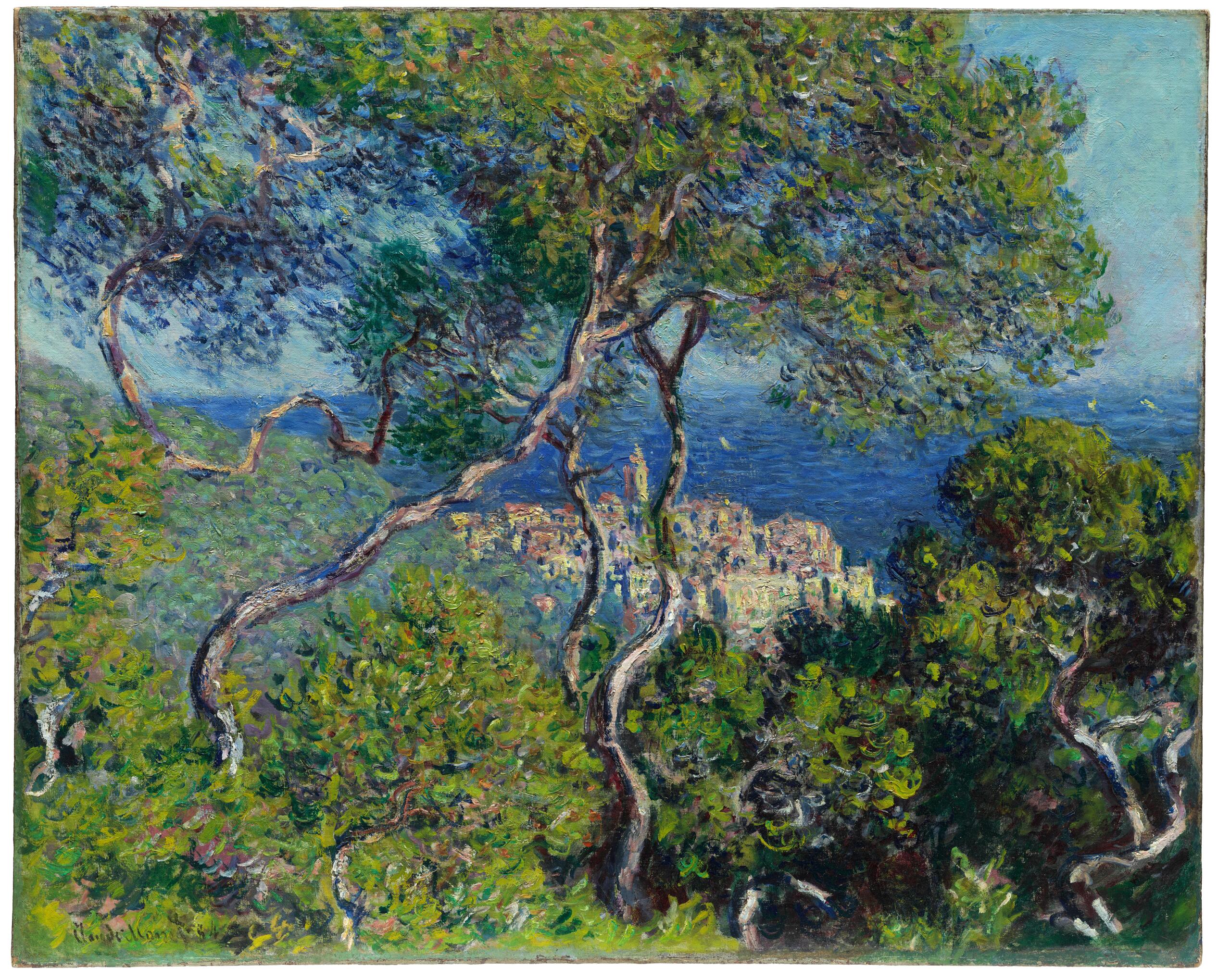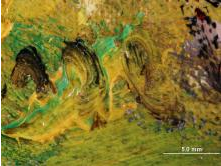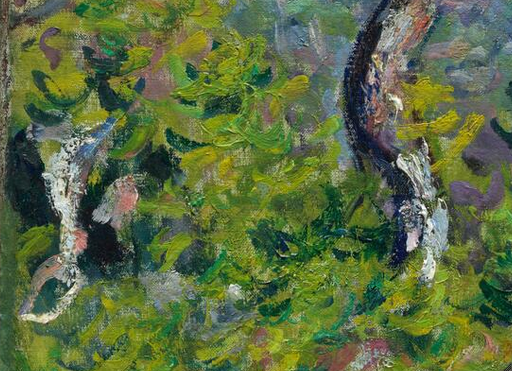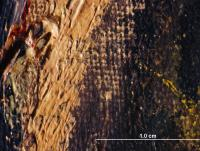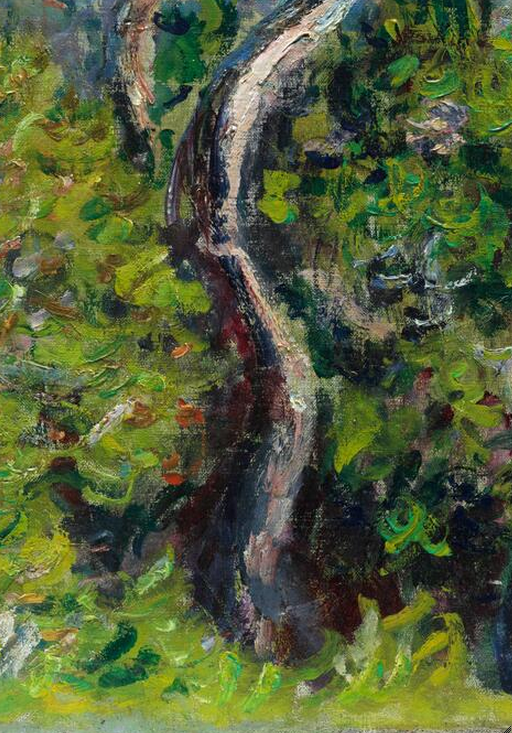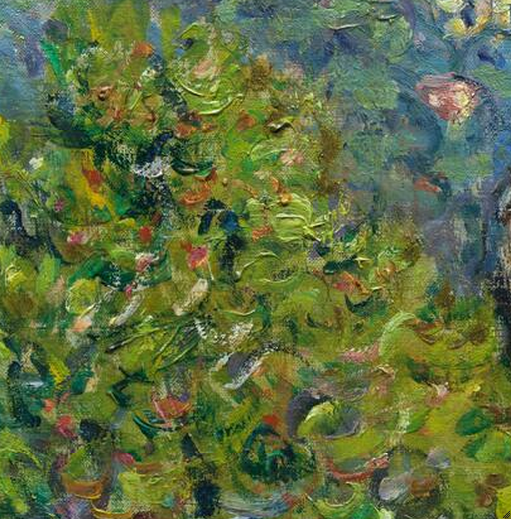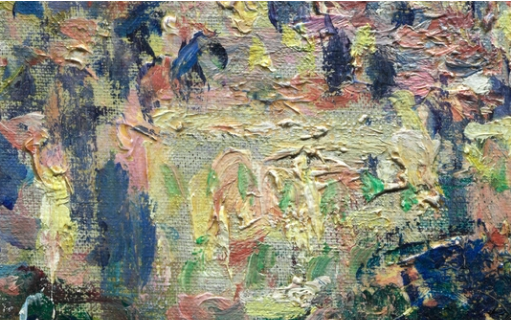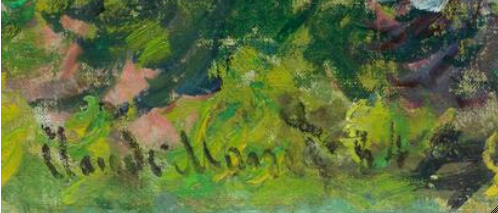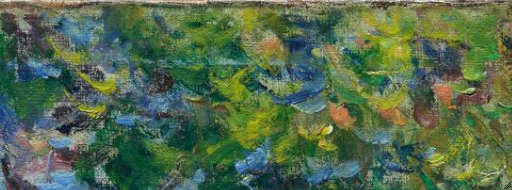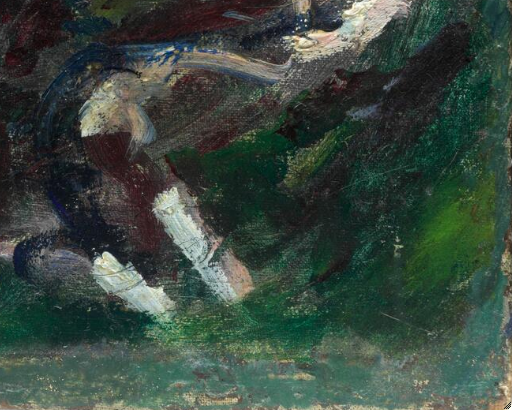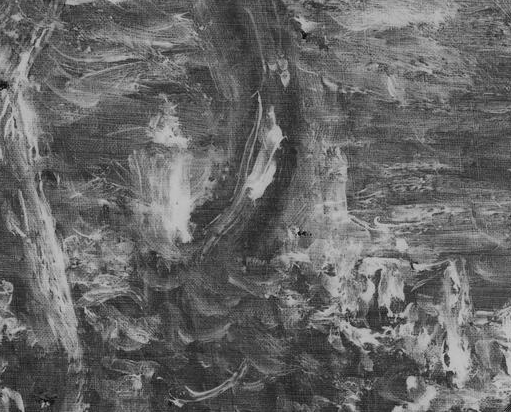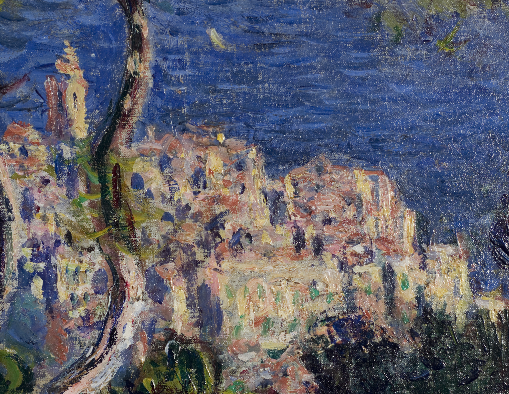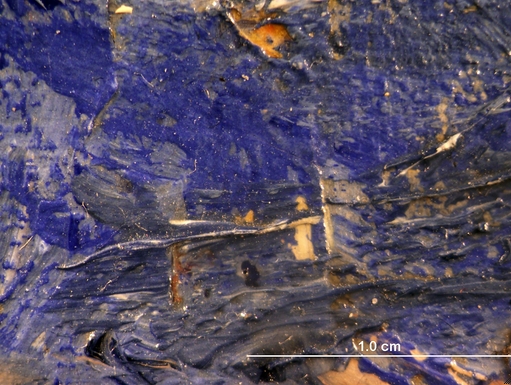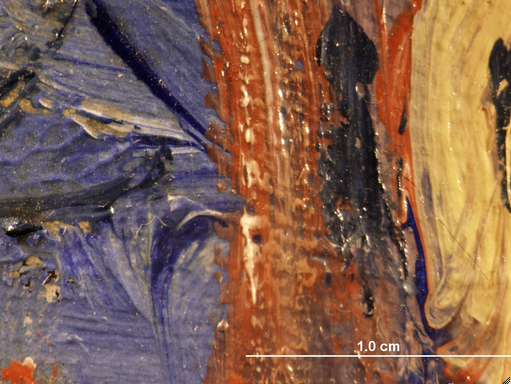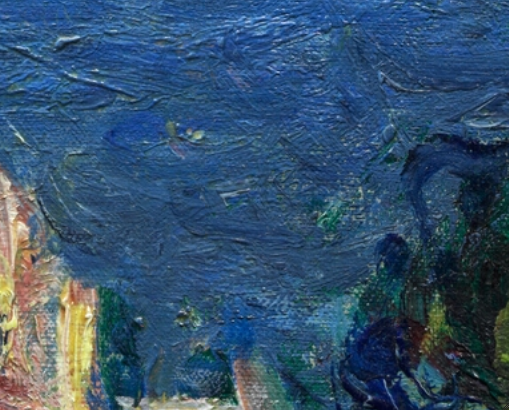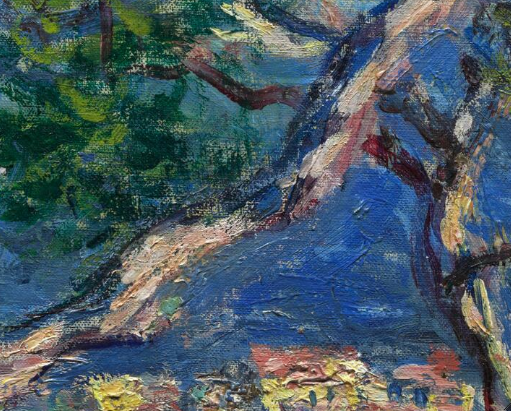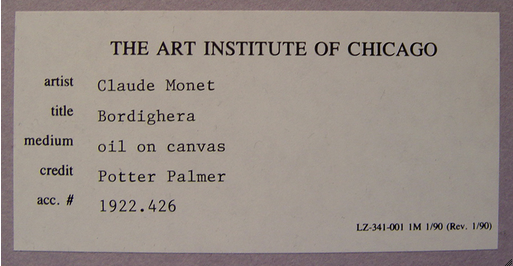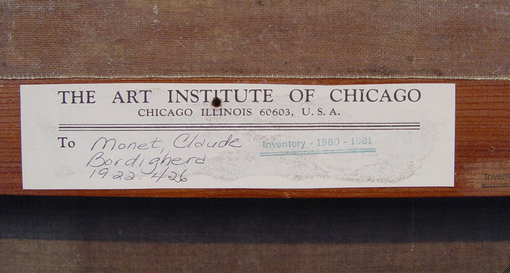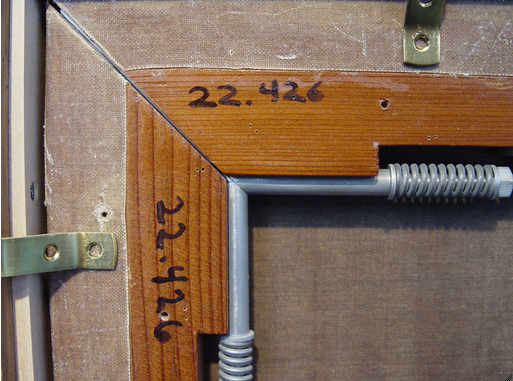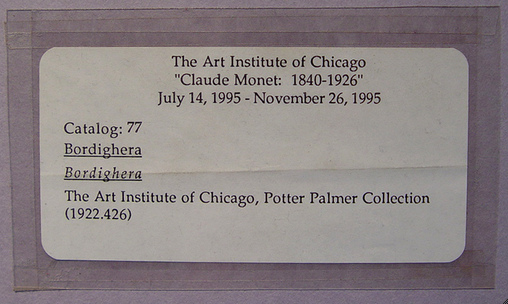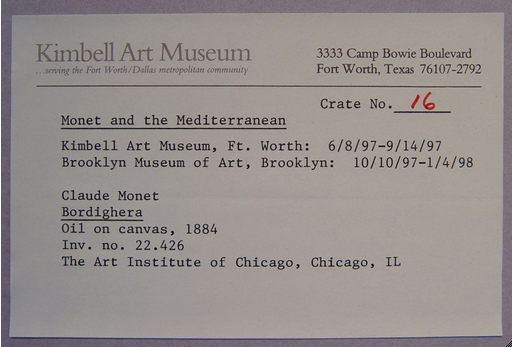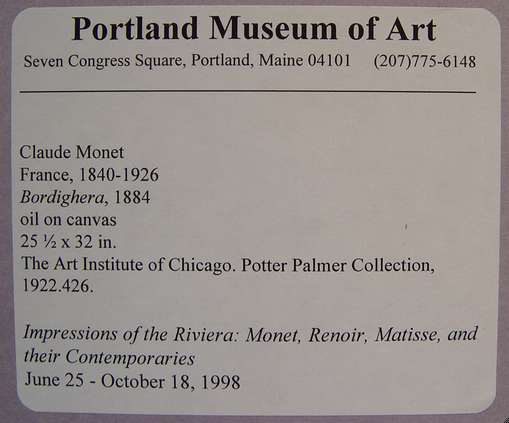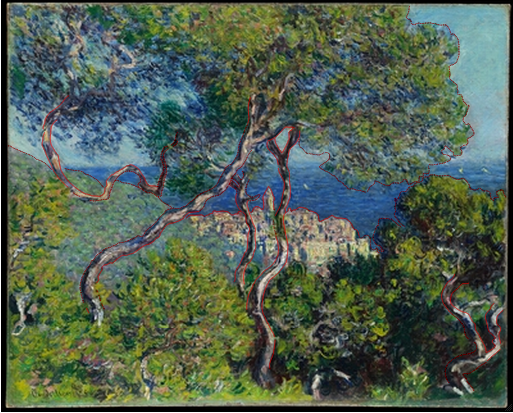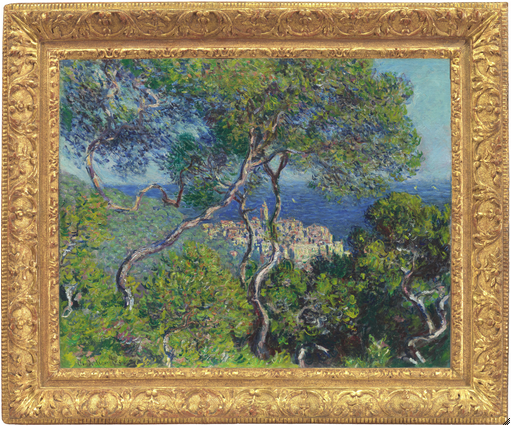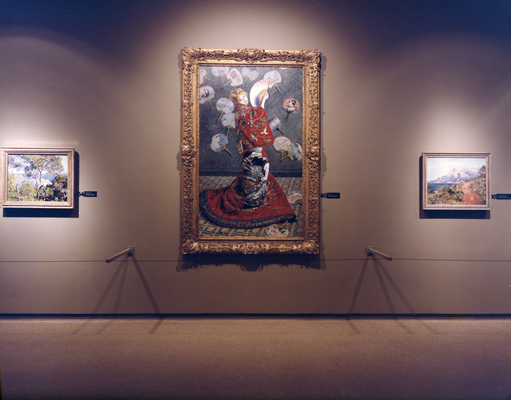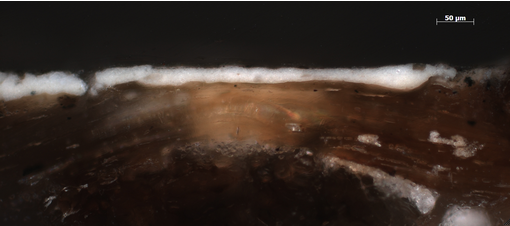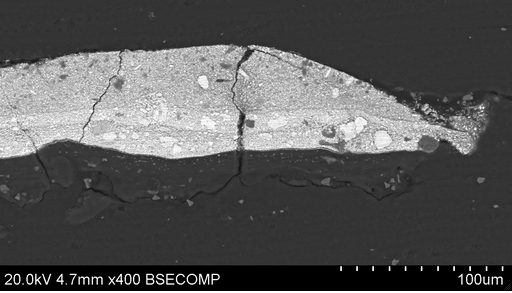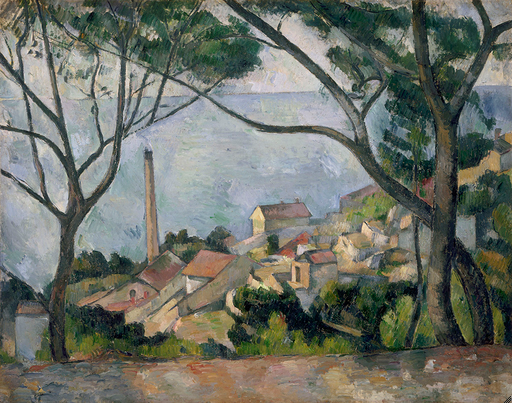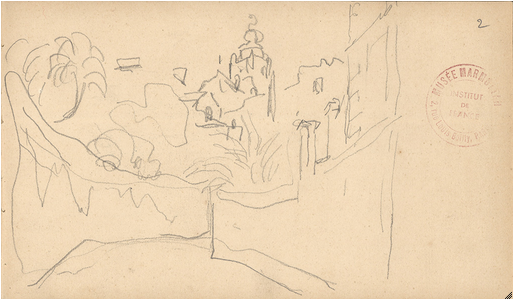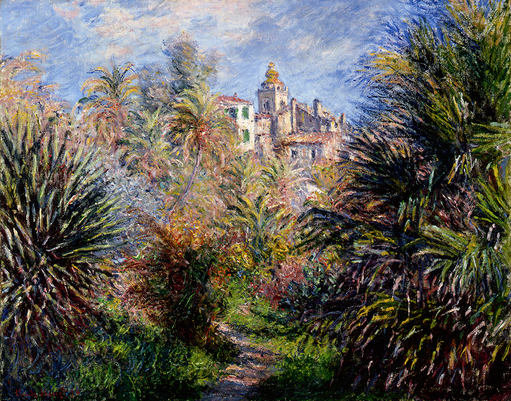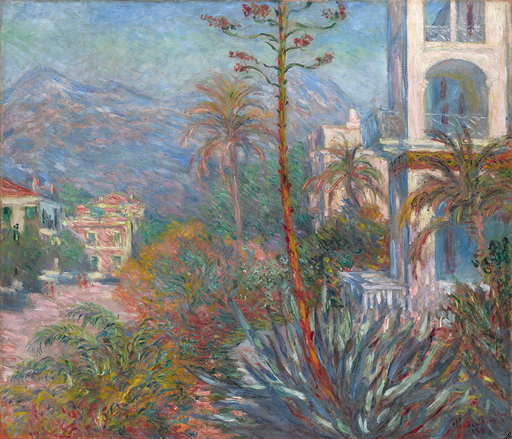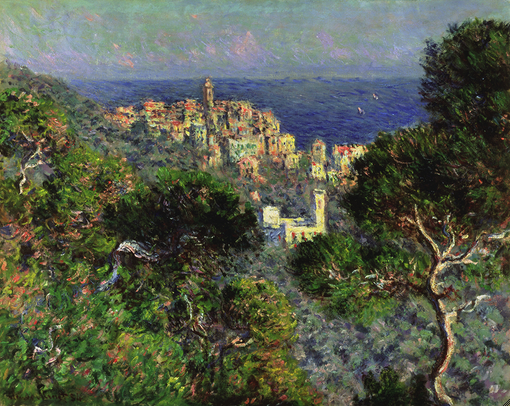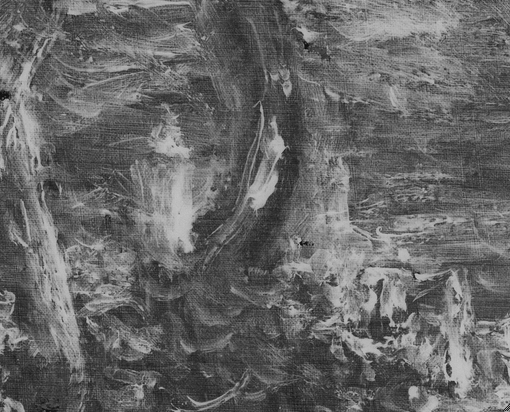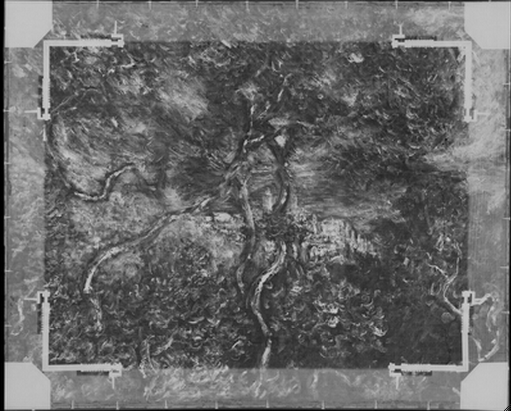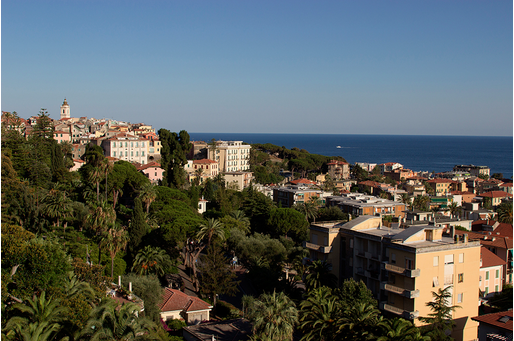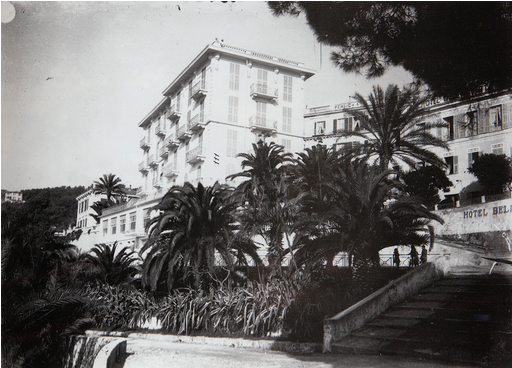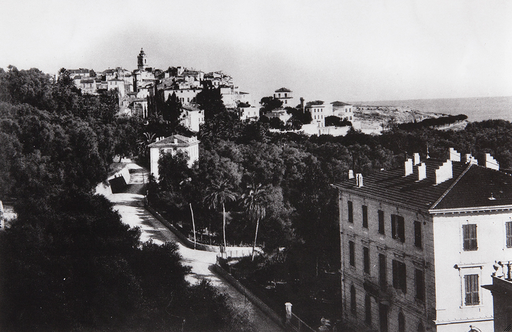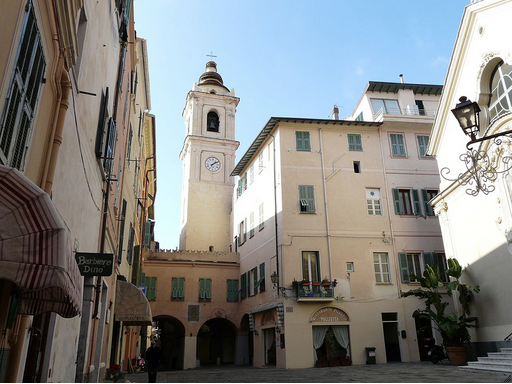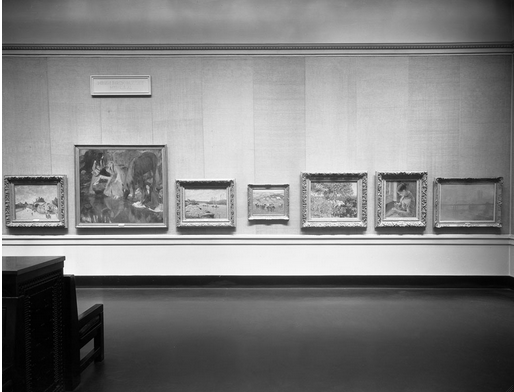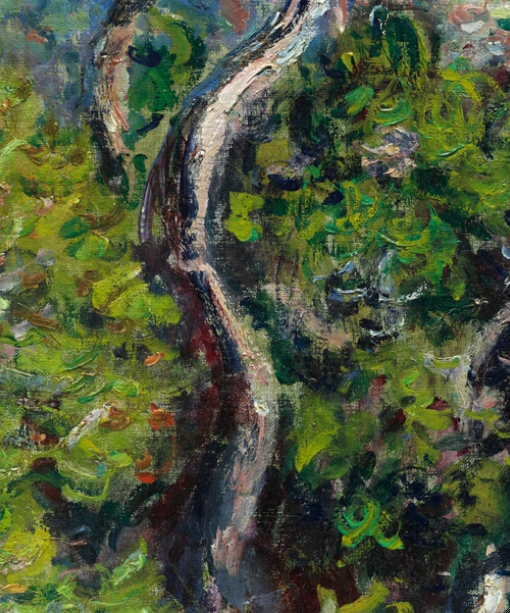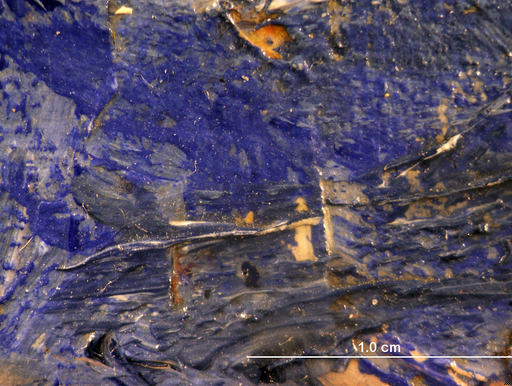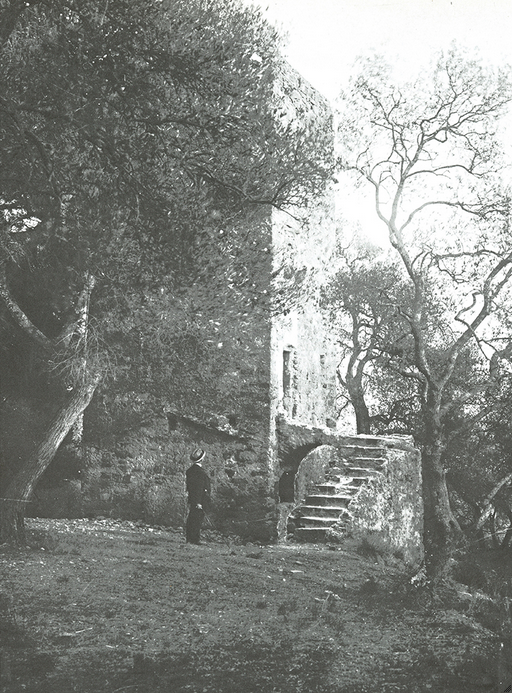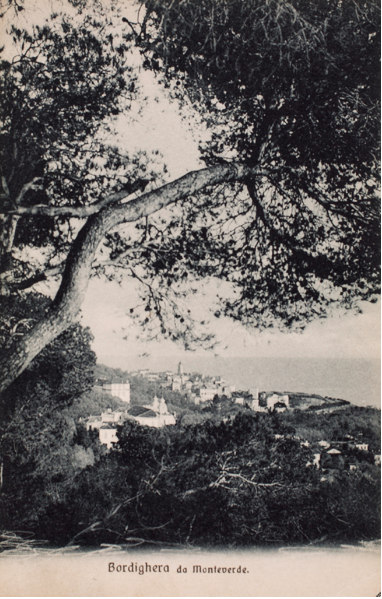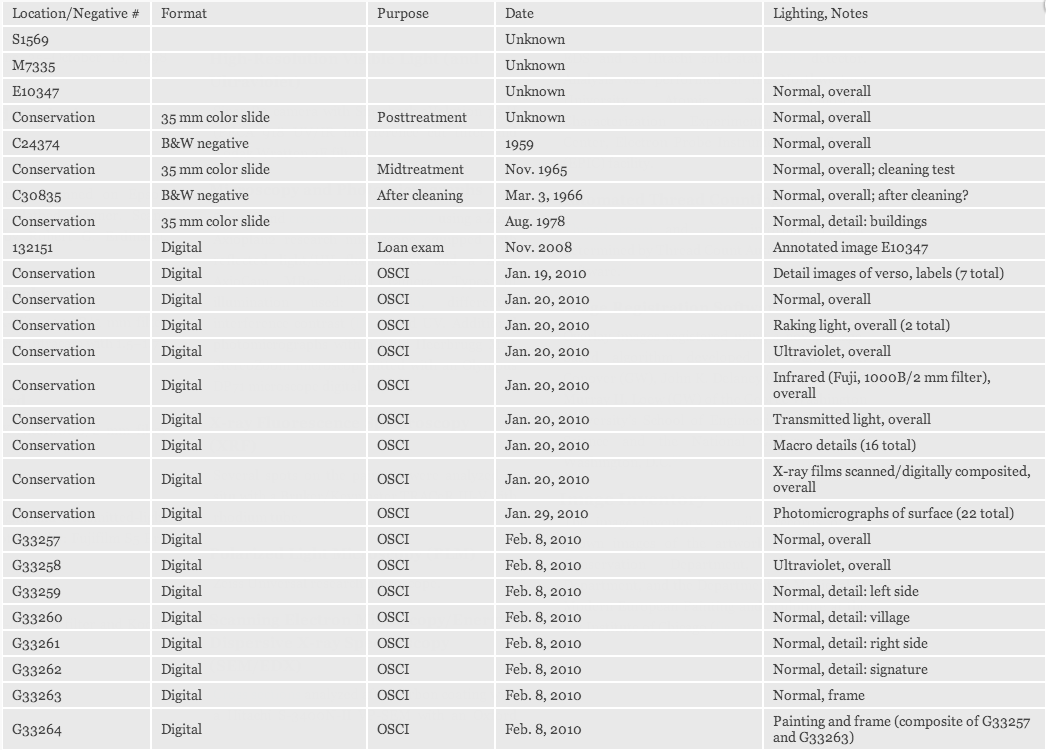Monet’s Bordighera Trio
Claude Monet was greatly impressed with the picturesque village of Bordighera, located on the Italian Riviera near the French border, when he toured the area with Pierre-Auguste Renoir in December 1883. Describing the town to his dealer, Paul Durand-Ruel, he called it “one of the most beautiful places” that they had visited, and he expressed his intention to return alone, in order “to bring back a series of new things.” A month later, Monet arrived in Bordighera, and from his base at the Pension Anglaise began to work intensely for what he initially estimated would be a period of three weeks but instead lasted for nearly three months. He would not return to France until mid-April 1884, but sent ahead the fruit of his labors: forty-five paintings, representing what the art historian Paul Tucker has estimated to be a painting every two days, and featuring a variety of views along the coast from Ventimigilia, Italy, to Monte Carlo and Menton, across the border in France.
Three of these depict Bordighera’s old, upper quarter, the cittá alta, on the Cape of Sant’Ampelio (fig. 20.1), seen from the same angle but at different elevations, looking down at the seaside village below. Compositionally, the Art Institute’s version is the most radical of the three; the interlaced trunks of the pines create a decorative screen that nearly obfuscates the picturesque subject of the sun-soaked village against the blue sea that is also the focus of the other two versions. Perhaps for this reason, this canvas was the only one of the three that Durand-Ruel did not buy following the artist’s return from the south. Four years later, Monet showed the three Bordighera canvases in his one-man exhibition, along with other works from his trip to the Franco-Italian coast, at the Sixth International Exhibition of Painting and Sculpture held at Galerie Georges Petit, Paris, in May–June 1887. The Chicago painting remained unsold until 1891, despite the praise it received from Monet’s future biographer, the art critic Gustave Geffroy, who called it an “extraordinary canvas, crammed with an eruption of unimaginable vegetation ablaze with light that bursts forth like the sudden appearance of the sun, making everything around it fade.”
The View from a Hill
Charles Stuckey credits the artist’s choice of a high vantage point and the arboreal framing device to the visit Monet made with Renoir to Paul Cézanne’s home at l’Estaque a few months prior; there he would have seen Cézanne’s views of this seaside village, made in series-like fashion, with a similar focus (fig. 20.2). But it is also clear from Monet’s letters home to his companion, Alice Hoschedé—complaining about the overly abundant foliage, which thrilled him even as it thwarted his attempts to isolate the appropriate motif—that his decision to position himself above the Mediterranean palms, pines, and olive trees was a necessary strategy.
Monet’s visit to the Italian Riviera in 1883 was a vacation from work, but he returned in January 1884 with missionary zeal, primed for battle and hoping to bring back paintings that would capture the region he felt required a “palette of diamonds and jewels because of the blues and pinks.” The Art Institute’s painting and two related canvases were among those he began after February 7, when he gained access to the private residence of Francesco Moreno on the Via Romana, a short walk from the Pension Anglaise near the città alta (fig. 20.3). The numerous pictures Monet painted there showcase Moreno’s property, especially the “pure fairyland garden” located along the Via Romana (fig. 20.4, fig. 20.5 [D277], and fig. 20.6 [W865]), including one promised to the artist Berthe Morisot as a decoration for the dining room of her recently finished home in Paris (fig. 20.7 [W857]). But for the Chicago painting and two related views Monet chose a vantage point outside the Moreno gardens, up the Via Romana to the area around the Torre dei Mostaccini (fig. 20.8), an ancient Roman watchtower surrounded by a stone wall.
The tower, overlooking Bordighera and its città alta, was a popular attraction, as evidenced by contemporary guidebook descriptions. It is even possible that Monet was aware of a contemporary guidebook to artistic views in Bordighera, Les motifs artistiques de Bordighera, by fellow Frenchman and architect of the Paris Opéra Charles Garnier, which included a description of the picturesque possibilities looking down from the tower:
We must now pass by the stone wall raised in front of the tower, and turn again into the little bridle-path which descends on our right, and by which we shall arrive almost immediately at the level plateau, where there is the cluster of pines which crowns that portion of the summit [emphasis added]. Before continuing the track which leads us back again to the plain, let us stop for a few moments on the pine crest and turn our eyes toward the left: here are at least four or five delightful subjects for our sketch-books, which seem to stand out from their surroundings, as if only waiting to be reproduced on canvas. This is an especially characteristic corner of Bordighera, and one which is not likely to be soon forgotten.
The picturesque view of Bordighera described here—seen from the path leading up to the tower and reproduced in a contemporary postcard (fig. 20.9)—was captured by Monet in three canvases. He seems to have set up his easel at three different elevations, each of which allowed the full vision of the skyline. Perhaps beginning at the plateau mentioned in the guidebook (fig. 20.10 [W852]), he gradually moved up the hill (fig. 20.11 [W853]) to finally arrive at the summit (the Chicago version), from where Bordighera appears nested, less panoramic, and secondary to its lush surroundings. The Art Institute painting is the only one of the three in which the twisted trunks and branches of pine trees nearly screen out the village. At the same time, the artist was careful not to block the tower of one of the topographical landmarks, the bell tower of the old city (fig. 20.12), moving it to the left so that it would not be hidden by the largest, centermost tree (fig. 20.13). Indeed, Monet seems to have privileged the trees, leaving them intact and painting over the bell tower (to accommodate its shifted position) after it was dry (fig. 20.14), as he did with some of the buildings and foliage at the right edge of the village, which once extended up a little bit more into what is now the water.
A Pattern of Pines
The most radical and distinguishing aspects of the painting are the patterns of pine trees, which curtain the seascape. X-ray images show that these were drawn in paint at the initial stage of the lay-in, while the rest of the composition, especially the town with the bell tower that he shifted to the left, seems to have been first laid in and then altered (fig. 20.15). Monet highlighted the trunks with long, impasted strokes of white paint to suggest the streaming sunlight on the hillside in contrast to the flecked, comma-like strokes that he used to describe the surrounding foliage (e.g., fig. 20.16).
As usual, the technical strategies Monet adopted in earlier landscapes and seascapes were now applied: capturing the main features of the motif with thinly applied brushstrokes, building the composition up from this initial lay-in, and employing wet-on-wet touches of color to add texture and highlights (see Technical Report). In the Chicago version especially, he painted wet-on-wet in the foliage but in other areas let the paint dry completely before returning to make changes or rework the original idea, such as in the tree trunk at right (fig. 20.17; see Technical Report). Added to his previous commitment to painting en plein air was the need to calculate and create chromatic harmonies. This required a large space, one that allowed him to spread out his canvases and assess his work to date. In a letter to Durand-Ruel in late April, Monet insisted that he be able to rework the paintings from his Italian trip before handing anything over to the gallery—a demand that underscored the importance the artist placed on the effect of the totality, of the ensemble, which could not be realized fully in front of the motif.
The village and landscape of Bordighera presented the artist with particular new challenges, including its rich vegetation, so different from the coast of Normandy. And its foreignness, which, coupled with his self-imposed isolation, pushed him out of the familiar into radical experimentations of color and light.
Gloria Groom
Technical Report
Technical Summary
Claude Monet’s Bordighera was painted on a pre-primed, no. 25 portrait (figure) standard-size linen canvas. The off-white ground layer consists of a single, or possibly double, application. The painting was built up using a variety of brush applications, including thinly applied strokes used for the initial lay-in of the composition; this was followed by a buildup of smooth, opaque brushstrokes and low impasto, and some final, light-handed strokes that skip across the surface of the underlying paint texture. The brushstrokes were applied in a relatively open network that leaves small areas of the ground layer exposed throughout the painting. Only a few minor revisions were made to the composition during painting. These include a change in the position of the bell tower, which was originally painted farther to the right on the other side of the adjacent tree. The buildings and foliage at the right edge of the village seem to have originally extended up a little farther into the area now occupied by the water. A slight adjustment was also made to the contour of the diagonal tree trunk, just above the left side of the village.
Multilayer Interactive Image Viewer
The multilayer interactive image viewer is designed to facilitate the viewer’s exploration and comparison of the technical images (fig. 20.18).
Signature
Signature/Stamp
Signed and dated: Claude Monet 84 (lower left corner, in dark-reddish-brown paint) (fig. 20.19). There is some wet-in-wet mixing with underlying paint layers, specifically, the bright-yellow and bright-green strokes of the foliage (fig. 20.20). These strokes may represent final touches added just before the painting was signed.
Structure and Technique
Support
Canvas
Flax (commonly known as linen).
Standard format
The dimensions correspond closely to a no. 25 portrait (figure) standard-size canvas (81 × 65 cm), turned horizontally.
Weave
Plain weave. Average thread count (standard deviation): 23.5V (1.5) × 19.3H (0.5) threads/cm. The horizontal threads were determined to correspond to the warp and the vertical threads to the weft. No weave matches were found with other Monet paintings analyzed for this project.
Canvas characteristics
Cusping is very pronounced and widely spaced along the right edge and strong along the bottom edge. There is mild, closely spaced cusping on the top edge. Cusping on the left edge is difficult to discern.
Stretching
Current stretching: Dates to 1966 treatment (see Conservation History); copper tacks spaced 7–9 cm apart.
Original stretching: The original tacking margins are deteriorated and abraded, with several losses to the fabric. The old tack holes, spaced 3–4 cm apart, probably represent two or more tacking campaigns. There are also some smaller, less deteriorated pinholes. The tack holes do not appear to correspond to the cusping pattern, but this is difficult to confirm since not all of the edges are intact. On the right edge, where cusping is most pronounced, the point of attachment seems to be well beyond the current edge of the fabric.
Stretcher/strainer
Current stretcher: Four-membered ICA spring stretcher. Depth: 2.5 cm.
Original stretcher: Discarded/not documented.
Manufacturer’s/supplier’s marks
None observed in the current examination or documented in previous examinations.
Preparatory Layers
Sizing
Not determined (probably glue).
Ground application/texture
The ground extends to the edges of all four tacking margins, indicating that the canvas was cut from a larger piece of primed fabric that was probably commercially prepared. The ground layer is relatively thin, and the canvas weave remains prominent. Cross-sectional analysis of a sample taken from the tacking edge suggests the presence of a single layer (fig. 20.21); however, the backscattered electron (BSE) image of a cross section taken from the picture plane indicates a possible double application (fig. 20.22). There are numerous old, tiny losses of paint and ground layers throughout the painting, as well as microcracking in the ground that corresponds to the weave of the canvas (fig. 20.23).
Color
The ground is off-white in color, with some dark particles observed under magnification.
Materials/composition
Analysis indicates that the ground contains lead white with traces of iron oxides, alumina, silica, barium sulfate, silicates, and calcium-based white.
Compositional Planning/Underdrawing/Painted Sketch
Extent/character
None detected with infrared reflectography (IRR) or microscopic examination.
Paint Layer
Application/technique and artist’s revisions
The work was painted using an open network of brushstrokes with small patches of exposed ground visible throughout. The composition was laid in using thinly applied strokes of paint that emphasize the texture of the canvas weave, and was then built up using thicker, more textural strokes and low impasto (fig. 20.24). The tree trunks and main branches were mapped out early on in the composition, with the landscape, sea, and sky built up around them. The trunks and branches were laid in using thinly applied, dark reddish-brown and purplish-gray strokes (fig. 20.25); this early brushwork was mostly covered by the subsequent buildup of paint, which includes both smooth and highly textured strokes, layered one over the other along the length of the trees (fig. 20.26). The sky was built up using varying shades of pale blue and gray, while the starting point for the water was a deeper blue. The foliage was laid in using individual touches of thinly applied color in relatively dull tones compared with the more brightly colored brushstrokes used in the upper paint layers (fig. 20.27, fig. 20.28). The painting was then built up using a variety of superimposed brush applications. This includes solid, relatively smooth strokes; thicker, more textural strokes and low impasto; as well as broken strokes where the paint was lightly dragged across the peaks of the underlying paint texture. Sometimes more than one color was picked up on the brush and laid down without any mixing. The strokes of bright-green and bright-yellow paint used throughout the landscape provide an example of this (fig. 20.29). The village is constructed almost entirely from individual short strokes and touches of color, which were applied openly so that the lighter areas of the buildings are actually exposed ground (fig. 20.30). The artist moved back and forth between different areas, working up the composition as a whole. The work incorporates both wet-in-wet and wet-over-dry paint application, and the fact that areas of thick impasto were already surface dry in some places when subsequent paint layers were applied on top (fig. 20.31) suggests that the painting was carried out over a period of time. The artist added a few finishing touches of bright-yellow and bright-green paint to the lower left corner, which were still wet when he signed the work (fig. 20.32).
For the most part, the composition was built up directly from the initial lay-in without any major alterations as the painting progressed. Only a few minor changes were observed. For example, in the middle ground, the position of the bell tower was relocated from the immediate right of the main foreground tree trunk to the left side of it (fig. 20.33). This could reflect a change in the artist’s vantage point after he had started the work, or it may have been an aesthetic or compositional decision. Traces of the first tower are visible in the form of vertical ridges of slightly thicker paint (fig. 20.34). There are also small areas of cream and pale-pink paint similar to that used for other buildings, which remain visible through breaks in the brushwork of the water that was applied on top (fig. 20.35). The undisturbed vertical ridges of the brushstrokes indicate that the paint from the tower was set up when the water was painted on top. The final bell tower was painted on top of the already-dry blue paint of the water in that area (fig. 20.36). These observations indicate that some time passed between the first painting of this area of the composition and the revisions. At the far right side of the village, there are some green, pink, and yellow strokes of paint visible underneath the water (fig. 20.37), which seem to indicate that the buildings and adjacent landscape may have extended further into the water in this area at an earlier stage of the painting. Other minor changes include a slight emendation to the lower contour of the diagonal tree trunk in the area where it passes over the water, just left of center. Here, the blue paint of the water to the right was extended over the lower edge of the trunk, making it narrower in that area, and the upper edge of the trunk was subsequently broadened slightly, with the result that the trunk dips less than it originally did in that area (fig. 20.38).
An intermittent band of pale-blue paint, on the left side near the top edge, appears to be the result of paint transfer, possibly from an easel cleat or transporting device (fig. 20.39). A few areas of scraping into soft paint were observed along the bottom edge. These marks appear to be incidental, probably related to handling of the work when it was still wet (fig. 20.40).
Painting tools
Brushes including 0.5 and 1 cm width, flat ferrule (based on width and shape of brushstrokes). Several brush hairs are embedded in the paint layers.
Palette
Analysis indicates the presence of the following pigments: lead white, cadmium yellow, chrome yellow, vermilion, red lake, emerald green, viridian, cobalt blue, and ultramarine blue. Areas of pinkish-orange UV fluorescence indicate that red lake was used in localized touches in the trees. A non-UV-fluorescing, deep-red lake was also observed in the shadowed areas at lower right and in the tree trunks and branches.
Binding media
Oil (estimated).
Surface Finish
Varnish layer/media
The painting has an even, slightly glossy, synthetic varnish, which was applied in 1966. There are residues of yellowed natural-resin varnish in the recesses of the paint texture. The natural-resin varnish was probably applied during the 1922 treatment (see Conservation History).
Conservation History
An undated memo in the conservation file states that the painting was cleaned and varnished in 1922.
The earliest examination report, dated 1957, indicates that the painting was already lined by that date. There are no further records indicating when the lining was carried out. The 1965 examination report states that the lining was aqueous (glue).
In 1965–66, discolored surface films were removed. The previous lining canvas was removed mechanically, resulting in some holes at weak spots in the original canvas, which were filled with a brown gesso. The canvas was wax-resin lined and stretched on a new ICA spring stretcher. A spray coating of polyvinyl acetate (PVA) AYAA was applied. Losses were inpainted. A spray coating of methacrylate resin L-46 was applied, followed by a final spray coating of AYAA.
Condition Summary
The painting is in good condition but has been impacted by previous damage and conservation treatments. The canvas is wax-resin lined and stretched taut on an ICA spring stretcher with no planar deformations. There are three vertical tears, ranging from 3 to 10 cm long, located approximately 10 cm in from the right edge, just inside the stretcher bar. The tears seemingly occurred while the artist was still working on the canvas, as original paint appears to span the damaged areas. The original tacking edges are deteriorated with tears and losses in the fabric and splits at the foldovers. There are numerous tiny losses of ground and paint layers throughout the painting. There are several places near the edges where tiny flakes of crushed and displaced ground and paint are adhered to the surface in thick wax-resin adhesive residues from the lining. There are also a few areas of flattened and moated impasto and crushed paint, which probably also occurred during lining. All of the previous damages and insecurities are stable. Cracking is minimal and, where present, is very fine and mainly visible only under magnification. Cracks are slightly more pronounced in areas of thick impasto. There are yellowed varnish residues in the recesses of the paint texture. Synthetic varnish applied in 1965/66 provides an even, saturated, slightly glossy surface. There is retouching around the edges; this is particularly extensive along the bottom. Several small, localized areas of mismatched retouching are visible within the painting. These appear to have been applied mainly to areas of loss where the canvas was exposed.
Kimberely Muir
Frame
Current frame (installed in 2007): The frame is not original to the painting. It is a French (Provençal), late-seventeenth–early-eighteenth-century, Louis XIV frame with carved acanthus-leaf corners linked by foliate scrollwork and strapwork with flowers on a quadrillage bed with a sanded frieze and an acanthus-leaf-tip-and-flower sight molding on a recut fluted ground. The frame is water gilded over red bole on gesso. The ornament and sight moldings are selectively burnished; all other gilding is matte. The frame retains its original glue size. The carved fruitwood molding is mitered with angled dovetails. The molding, from perimeter to interior, is leaf-tip outer molding; scotia side; ogee with carved acanthus-leaf corners linked by continuous foliate scrollwork and strapwork with flowers on a quadrillage bed; sanded front frieze: ogee with carved acanthus-leaf tip and flowers on a recut fluted ground (fig. 20.41).
Previous frame (installed by 1975; removed in 2007): The work was previously housed in an American, twentieth-century, stylized, late-nineteenth-century, French-inspired molding frame with cast plaster foliate ornament and cove sight edge. The frame has both water and oil gilding with heavy toning (fig. 20.42).
Previous frame (installed by 1933): In the Century of Progress exhibition (1933–34), the painting was displayed in a late-nineteenth–early-twentieth-century, Louis XIV Revival, convex frame with deeply recessed cast plaster acanthus-leaf corners, foliate and fleur-de-lis ornament, and independent fillet liner with cove sight (fig. 20.43).
Kirk Vuillemot
Selected References
Gustave Geffroy, “Salon de 1887. Hors du Salon: Claude Monet,” La justice, pt. 2 (June 2, 1887), p. 1.
Gustave Geffroy, “Histoire de l’impressionnisme,” La vie artistique 3, 2 (1894), p. 70.
Copley Society, Loan Collection of Paintings by Claude Monet and Eleven Sculptures by August Rodin, exh. cat. (Copley Society, 1905), p. 15, cat. 18.
Art Institute of Chicago, Paintings from the Collection of Mrs. Potter Palmer, exh. cat. (Art Institute of Chicago, 1910), cat. 33.
Art Institute of Chicago, “Accessions and Loans,” Bulletin of the Art Institute of Chicago 16, 3 (May 1922), p. 47.
Art Institute of Chicago, Handbook of Sculpture, Architecture, and Paintings, pt. 2, Paintings (Art Institute of Chicago, 1922), p. 68, cat. 830.
Gustave Geffroy, Claude Monet: Sa vie, son temps, son oeuvre (G. Crès, 1922), p. 273.
M. C., “Monets in the Art Institute,” Bulletin of the Art Institute of Chicago 19, 2 (Feb. 1925), p. 19.
Art Institute of Chicago, A Guide to the Paintings in the Permanent Collection (Art Institute of Chicago, 1925), p. 146, cat. 830.
Art Institute of Chicago, Catalogue of “A Century of Progress”: Exhibition of Paintings and Sculpture; Lent from American Collections, ed. Daniel Catton Rich, 3rd ed., exh. cat. (Art Institute of Chicago, 1933), p. 43, cat. 290A.
Daniel Catton Rich, “Französische Impressionisten im Art Institute zu Chicago,” Pantheon: Monatsschrift für freunde und sammler der kunst 11, 3 (Mar. 1933), p. 77. Translated by C. C. H. Drechsel as “French Impressionists in the Art Institute of Chicago,” Pantheon/Cicerone (Mar. 1933), p. 18.
Art Institute of Chicago, Catalogue of “A Century of Progress”: Exhibition of Paintings and Sculpture, 1934, ed. Daniel Catton Rich, exh. cat. (Art Institute of Chicago, 1934), p. 36, cat. 207.)
Toledo Museum of Art, Catalogue: French Impressionists and Post-Impressionists, exh. cat. (Toledo Museum of Art, 1934), cat. 9.
George Slocombe, “Giver of Light,” Coronet (Mar. 1938), p. 25 (ill.).
Oscar Reuterswärd, Monet: En konstnärshistorik (Bonniers, 1948), opp. 104 (ill.); p. 285.
Kenneth Clark, Landscape into Art (John Murray, 1949), pp. xiii; 93; pl. 83.
Art Institute of Chicago, An Illustrated Guide to the Collections of the Art Institute of Chicago (Art Institute of Chicago, 1956), p. 34.
Art Institute of Chicago, ”Homage to Claude Monet,” Art Institute of Chicago Quarterly 51, 2 (Apr. 1, 1957), p. 24.
Art Institute of Chicago, “Catalogue,” Art Institute of Chicago Quarterly 51, 2 (Apr. 1, 1957), p. 33.
Art Institute of Chicago, “Chronology,” Art Institute of Chicago Quarterly 51, 2 (Apr. 1, 1957), p. 30 (ill.).
Claude Monet: A Loan Exhibition, exh. cat. (Minneapolis Society of the Fine Arts, 1957), pp. 64; 65, cat. 58 (ill.).
Edith Weigle, “The Wonderful World of Art,” Chicago Daily Tribune, May 26, 1957, p. E2.
William C. Seitz, “Claude Monet’s View of Nature,” in Claude Monet: A Loan Exhibition, exh. cat. (Minneapolis Society of the Fine Arts, 1957), pp. 24, 30.
Denis Rouart, Claude Monet, trans. James Emmons (Skira, 1958), pp. 80 (ill.), 129.
Art Institute of Chicago, Paintings in the Art Institute of Chicago: A Catalogue of the Picture Collection (Art Institute of Chicago, 1961), p. 319.
Yvon Taillandier, Monet, trans. A. P. H. Hamilton (Crown, [1963]), pp. 56, 58 (ill.).
Luigina Rossi Bortolatto, L’opera completa di Claude Monet: 1870–1889, Classici dell’arte 63 (Rizzoli, 1972), pp. 105; 106, cat. 270 (ill.).
Grace Seiberling, “The Evolution of an Impressionist,” in Paintings by Monet, ed. Susan Wise, exh. cat. (Art Institute of Chicago, 1975), p. 30.
Susan Wise, ed., Paintings by Monet, exh. cat. (Art Institute of Chicago, 1975), p. 118, cat. 64 (ill.).
Rodolphe Walter, with the assistance of Giuseppe E. Bessone, “Charles Garnier et Claude Monet à Bordighera,” L’oeil 258–59 (Jan.–Feb. 1977), p. 26 (ill.).
Roger Terry Dunn, “The Monet-Rodin Exhibition at the Galerie Georges Petit in 1889” (Ph.D. diss., Northwestern University, 1978), pp. iii; 121; 272, ill. 5.
Daniel Wildenstein, Claude Monet: Biographie et catalogue raisonné, vol. 2, Peintures, 1882–1886 (Bibliothèque des Arts, 1979), pp. 23; 114; 115, cat. 854 (ill.); 253, letter 498.
Daniel Wildenstein, Claude Monet: Biographie et catalogue raisonné, vol. 3, Peintures, 1887–1898 (Bibliothèque des Arts, 1979), p. 2, n. 621.
J. Patrice Marandel, The Art Institute of Chicago: Favorite Impressionist Paintings (Crown, 1979), pp. 58–59 (ill.).
Diane Kelder, The Great Book of French Impressionism (Abbeville, 1980), p. 211 (ill.).
Hélène Adhémar, Anne Distel, and Sylvie Gache, Hommage à Claude Monet (1840–1926), exh. cat. (Réunion des Musées Nationaux, 1980), pp. 256–58, cat. 88 (ill.).
Jacqueline and Maurice Guillaud, Claude Monet au temps de Giverny, exh. cat. (Centre Culturel du Marais, 1983), pp. 24; 26–27, fig. 9/cat. 7; 32–33. Translated as Jacqueline and Maurice Guillaud, Claude Monet at the time of Giverny, exh. cat. (Centre Culturel du Marais, 1983), pp. 24; 26–27, fig. 9/cat. 7; 32–33.
Robert Gordon and Andrew Forge, Monet (Abrams, 1983), pp. 110 (ill.), 291.
Art Institute of Chicago, Seibu Museum of Art, Kyoto Municipal Museum of Art, and Fukuoka Art Museum, eds., Shikago bijutsukan insho-ha ten [The Impressionist tradition: Masterpieces from the Art Institute of Chicago], trans. Akihiko Inoue, Hideo Namba, Heisaku Harada, and Yoko Maeda, exh. cat. (Nippon Television Network, 1985), pp. 92, cat. 42 (ill.); 150–51, cat. 42 (ill.).
Daniel Wildenstein, Claude Monet: Biographie et catalogue raisonné, vol. 4, Peintures, 1899–1926 (Bibliothèque des Arts, 1985), p. 44, n. 412.
John House, Monet: Nature into Art (Yale University Press, 1986), pp. 195; 196, pl. 245.
Richard R. Brettell, French Impressionists (Art Institute of Chicago/Abrams, 1987), pp. 75, 77 (ill.), 118.
Francesco Arcangeli, Monet (Nuova Alfa, 1989), pp. 55; 119, fig. 45; 155.
Richard Kendall, ed., Monet by Himself: Paintings, Drawings, Pastels, Letters, trans. Bridget Strevens Romer (Macdonald Orbis, 1989), pp. 147 (ill.), 319.
Karin Sagner-Düchting, Claude Monet, 1840–1926: Ein Fest für die Augen (Benedikt Taschen, 1990), p. 137 (ill.). Translated by Karen Williams as Claude Monet, 1840–1926: A Feast for the Eyes (Taschen, 2004), p. 137 (ill.).
Rachel Barnes, ed., Monet by Monet, Artists by Themselves (Webb & Bower, 1990), pp. 42–43 (ill.).
Daniel Wildenstein, Claude Monet: Catalogue raisonné, vol. 5, Supplément aux peintures: Dessins; Pastels; Index (Wildenstein Institute, 1991), p. 41.
Michael Howard, ed., The Impressionists by Themselves: A Selection of Their Paintings, Drawings and Sketches with Extracts from their Writings (Conran Octopus, 1991), p. 249 (ill.).
Bernd Küster, Monet: Seine Reisen in den Süden (Ellert and Richter, 1992), pp. 24–25, fig. 1.
Sophie Fourny-Dargère, Monet, Profils de l’art (Chêne, 1992), p. 153, fig. 22.
Christoph Heinrich, Claude Monet, 1840–1926 (Benedikt Taschen, 1993), pp. 63 (ill.), 95.
Art Institute of Chicago, Treasures of 19th- and 20th-Century Painting: The Art Institute of Chicago, with an introduction by James. N. Wood (Art Institute of Chicago/Abbeville, 1993), p. 96 (ill.).
Steven Z. Levine, Monet, Narcissus, and Self-Reflection: The Modernist Myth of the Self (University of Chicago Press, 1994), pp. 41; fig. 39; 94.
Paul Hayes Tucker, Claude Monet: Life and Art (Yale University Press, 1995), pp. 120; 121, fig. 137.
Charles F. Stuckey, with the assistance of Sophia Shaw, Claude Monet, 1840–1926, exh. cat. (Art Institute of Chicago/Thames & Hudson, 1995), pp. 13; 17; 98, cat. 77 (ill.); 210; 215; 237.
Andrew Forge, Monet, Artists in Focus (Art Institute of Chicago, 1995), pp. 29–31; 33 (detail); 34; 79, pl. 8; 107.
Daniel Wildenstein, Monet, or The Triumph of Impressionism, cat. rais., vol. 1 (Taschen/Wildenstein Institute, 1996), pp. 198, 200 (ill.).
Daniel Wildenstein, Monet: Catalogue raisonné/Werkverzeichnis, vol. 2, Nos. 1–968 (Taschen/Wildenstein Institute, 1996), pp. 316, cat. 854 (ill.); 319.
Stephan Koja, Claude Monet, exh. cat. (Österreichische Galerie/Prestel, 1996), pp. 27 (ill.), 100. Translated by John Brownjohn as Claude Monet, exh. cat. (Österreichische Galerie/Prestel, 1996), pp. 26, 27 (ill.).
Genevieve Morgan, ed., Monet: The Artist Speaks (Collins, 1996), pp. 53 (ill.), 95.
Helen Dudar, “Monet on the Mediterranean: When Light Meets Water,” Smithsonian (July 1997), p. 81 (detail).
Joachim Pissarro, Monet and the Mediterranean, exh. cat. (Kimbell Art Museum/Rizzoli, 1997), pp. 31; 37; 74; 76, pl. 4; 182, n. 52.
Kimbell Art Museum, “Monet and the Mediterranean,” Calendar (Feb.–Aug. 1997), p. 11 (ill.).
Meyer Schapiro, Impressionism: Reflections and Perceptions (Braziller, 1997), pp. 72, fig. 22; 73; 348.
Silvia Alborno, Monet: A Bordighera, exh. cat. (Città di Bordighera/Leonardo Periodici, 1998), p. 86 (ill.).
Matthias Arnold, Claude Monet, Rowohlts Monographien (Rowohlt, 1998), back cover (ill.), pp. 16, 17 (ill.).
Scott Heller, “The Good, the Bad & the Hard to Look at,” Artnews (Dec. 1998), p. 123 (ill.).
Kenneth Wayne, Impressions of the Riviera: Monet, Renoir, Matisse and Their Contemporaries, exh. cat. (Portland Museum of Art, 1998), pp. 6, fig. 2; 7; 78, cat. 50.
Thomas McBurney, Artistic Greatness: A Comparative Exploration of Michelangelo, Beethoven, and Monet (Galde, 1999), p. 287 (ill.).
Renaud Temperini, “Estetiche della modernità,” in La pittura francese, vol. 3, ed. Pierre Rosenberg, trans. Cosima Campagnolo, Valentina Palombi, and Stefano Salpietro (Electra, 1999), pp. 801, fig. 815; 806.
Vanessa Potts, Essential Monet, with an introduction by Claire I. R. O’Mahony (Dempsey Parr/Parragon, 1999), pp. 142–43 (ill.).
Vivian Russell, Monet’s Landscapes (Frances Lincoln, 2000), pp. 20 (ill.), 160.
Art Institute of Chicago, Impressionism and Post-Impressionism in the Art Institute of Chicago, selected by James N. Wood (Art Institute of Chicago/Hudson Hills, 2000), p. 75 (ill.).
Maria Teresa Benedetti, Monet: I luoghi (Giunti, 2001), p. 177 (ill.).
Fabrizio d’Amico, “Monet e il Mediterraneo: Da Bordighera ad Antibes,” in Monet: I luoghi della pittura, ed. Marco Goldin, exh. cat. (Linea d’Ombra Libri, 2001), p. 177 (ill.).
Norio Shimada and Keiko Sakagami, Kurodo Mone meigashu: Hikari to kaze no kiseki [Claude Monet: 1881–1926], vol. 2 (Nihon Bijutsu Kyoiku Senta, 2001), pp. 52, no. 185 (ill.); 189.
Richard R. Brettell, From Monet to Van Gogh: A History of Impressionism, vol. 2 (Teaching Co., 2002), pp. 78, 89, 179.
Guido Giuffrè, “Monet e l’arte italiana nell’ultimo quarto dell’Ottocento,” in Monet: Atti del convegno, ed. Rodolphe Rapetti, MaryAnne Stevens, Michael Zimmerman, and Marco Goldin (Linea d’Ombra, 2003), p. 22 (ill.).
Chris Stolwijk, Sjraar van Heugten, Leo Jansen, and Andreas Blühm, eds., Vincent’s Choice: Van Gogh’s Musée Imaginaire, exh. cat. (Van Gogh Museum/Thames & Hudson, 2003), pp. 273, pl. 138; 308.
Richard Thomson, “Monet e il mare di Nettuno: Bordighera, 1884. Antibes, 1888,” in L’oro e l’azzurro: I colori del sud da Cézanne a Bonnard, ed. Marco Goldin, trans. Viviana Tonon, exh. cat. (Linea d’Ombra Libri, 2003), pp. 69, 70, 71 (ill.).
Nienke Bakker, “Chronology: Vincent van Gogh as Connoisseur and Bookworm,” in Vincent’s Choice: Van Gogh’s Musée Imaginaire, ed. Chris Stolwijk, Sjraar van Heugten, Leo Jansen, and Andreas Blühm, exh. cat. (Van Gogh Museum/Thames & Hudson, 2003), p. 305.
Eleanor Dwight, ed., The Letters of Pauline Palmer: A Great Lady of Chicago’s First Family (M. T. Train/Scala, 2005), pp. 301 (ill.), 302.
Birgit Zeidler, Claude Monet: Life and Work, trans. Paul Aston in association with Goodfellow & Egan (Könemann, 2005), p. 58 (ill.).
Richard Thomson, “Monet and Neptune’s Sea: Bordighera 1884. Antibes, 1888,” in Right under the Sun: Landscape in Provence, From Classicism to Modernism (1750–1920), ed. Guy Cogeval and Marie-Paule Vial, exh. cat. (Montreal Museum of Fine Arts/Snoeck, 2005), pp. 115; 116; 118, fig. 3; 119.
Guy Cogeval and Marie-Paule Vial, eds., Right under the Sun: Landscape in Provence, From Classicism to Modernism (1750–1920), exh. cat. (Montreal Museum of Fine Arts/Snoeck, 2005), p. 259.
Jesse Matz, “Cultures of Impression,” in Bad Modernisms, ed. Douglas Mao and Rebecca L. Walkowitz (Duke University Press, 2006), pp. 313; 314, fig. 7 (detail).
Christiane Eluère, Monet et la Riviera (Citadelle & Mazenod, 2006), pp. 46–47, ill. 35; 48; 175, ill. 135.
Charles F. Stuckey, “Monet’s Path at Cap Martin: Adding a Very Big Piece to the Impressionist Puzzle,” in Wildenstein and Co., Claude Monet (1840–1926): A Tribute to Daniel Wildenstein and Katia Granoff, exh. cat. (Wildenstein, 2007), pp. 61, 62.
Sotheby’s, London, Impressionist & Modern Art Evening Sale, sale cat. (Sotheby’s, London, Feb. 5, 2007), pp. 20, fig. 2; 21.
Gloria Groom and Douglas Druick, with the assistance of Dorota Chudzicka and Jill Shaw, The Impressionists: Master Paintings from the Art Institute of Chicago, exh. cat. (Art Institute of Chicago/Kimbell Art Museum, 2008), pp. 13; 106–07, cat. 47 (ill.). Simultaneously published as Gloria Groom and Douglas Druick, with the assistance of Dorota Chudzicka and Jill Shaw, The Age of Impressionism at the Art Institute of Chicago (Art Institute of Chicago/Yale University Press, 2008), pp. 13; 106–07, cat. 47 (ill.).
Jon Kear, The Treasures of the Impressionists (Andre Deutsch, 2008), pp. 58 (ill.), 72.
Susie Hodge, Monet: His Life and Works in 500 Images (Lorenz, 2009), p. 62 (detail).
Pascal Bonafoux, Monet, peintre de l’eau (Du Chêne/Hachette, 2010), pp. 82 (ill.), 173.
Manlio Brusatin, “Mediterraneo. La strada dei colori,” in Mediterraneo: Da Courbet a Monet a Matisse, ed. Marco Goldin, exh. cat. (Linea d’Ombra, 2010), p. 65.
Ségolène Le Men, Monet (Citadelles & Mazenod, 2010), pp. 248–49, ill. 200.
Claire Maingon and Félicie de Maupeou, La bibliothèque de Monet, under the direction of Ségolène Le Men, exh. cat. (Citadelles & Mazenod, 2013), p. 45 (ill.).
